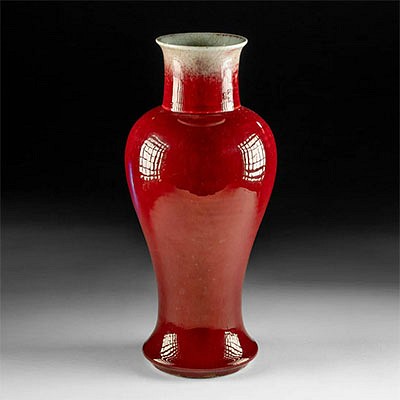Rare Large Chinese Han Pottery Goose Vessel, Zun
Lot 142
About Seller
Artemis Fine Arts
686 S Taylor Ave, Ste 106
Louisville, CO 80027
United States
Selling antiquities, ancient and ethnographic art online since 1993, Artemis Gallery specializes in Classical Antiquities (Egyptian, Greek, Roman, Near Eastern), Asian, Pre-Columbian, African / Tribal / Oceanographic art. Our extensive inventory includes pottery, stone, metal, wood, glass and textil...Read more
Categories
Estimate:
$3,200 - $4,800
Absentee vs Live bid
Two ways to bid:
- Leave a max absentee bid and the platform will bid on your behalf up to your maximum bid during the live auction.
- Bid live during the auction and your bids will be submitted real-time to the auctioneer.
Bid Increments
| Price | Bid Increment |
|---|---|
| $0 | $25 |
| $300 | $50 |
| $1,000 | $100 |
| $2,000 | $250 |
| $5,000 | $500 |
| $10,000 | $1,000 |
| $20,000 | $2,500 |
| $50,000 | $5,000 |
| $100,000 | $10,000 |
| $200,000 | $20,000 |
About Auction
By Artemis Fine Arts
May 11, 2023
Set Reminder
2023-05-11 10:00:00
2023-05-11 10:00:00
America/New_York
Bidsquare
Bidsquare : Fine Antiquities, Asian, Pre-Columbian, Ethnographic Art
https://www.bidsquare.com/auctions/artemis-gallery/fine-antiquities-asian-pre-columbian-ethnographic-art-12771
Classical antiquities, ancient and ethnographic art from cultures encompassing the globe. Artemis Fine Arts info@artemisfinearts.com
Classical antiquities, ancient and ethnographic art from cultures encompassing the globe. Artemis Fine Arts info@artemisfinearts.com
- Lot Description
**Originally Listed At $1800**
China, Han Dynasty, ca. 206 BCE to 220 CE. A playful yet elegant pottery wine vessel known as a zun in the form of a seated goose. Enveloped in matte gray pigment, the ancient avian presents a bulbous body that tapers to a slender curved neck with a prominent crown, a delineated eye, and a flattened beak. A relief spiral design adorns the areas above each eye. Several goose-shaped objects have come down to us from the Western Han era (206 BC-AD 9). The theme probably symbolized prosperity, as in the widely reproduced lamps. These terracotta pouring vessels in the shape of a goose are rarer. Under the Eastern Han dynasty (AD 25-220), numerous mingqi depict ducks and geese, often in relation with modelli of farms. The production of large fowl-shaped pieces appears to have ceased in this period. Light remains of painted detail adorn the surface of this example, with a zigzag linear design encompassing the neck. Size: 9.8" W x 13.7" H (24.9 cm x 34.8 cm)
Even at this early date, ceramic production in China was nationwide and regulated by the government, leading to uniform standards and styles across a vast geographic area. The grey color of this vessel resulted from firing it in a smoke-infused kiln. Tomb figures like this one are part of a class of artifacts called mingqi - sometimes known as "spirit utensils" or "vessels for ghosts". They became popular in the Han Dynasty and would persist for several centuries. Alongside figures like this one were other animals, musicians, athletes, structures… anything the deceased might need to recreate the world of the living. Even though they were mass produced, mingqi of the Han Dynasty often show a high level of detail and naturalism. These were designed to assist the po, the part of the soul of the deceased that remained underground with the body while the hun, the other part of the soul, ascended. Caring for the po seems to have taken on a new level of meaning in the Han period, with more elaborate rituals and tomb construction arising.
A similar example can be found at the Metropolitan Museum of Art (1994.605.17) and Cernuschi Museum, Paris (M.C. 9913).
Provenance: private Vero Beach, Florida, USA collection, acquired before 2003
All items legal to buy/sell under U.S. Statute covering cultural patrimony Code 2600, CHAPTER 14, and are guaranteed to be as described or your money back.
A Certificate of Authenticity will accompany all winning bids.
We ship worldwide and handle all shipping in-house for your convenience.
#177325Expected nicks and abrasions with a few stable hairline fissures to neck. Otherwise, intact and excellent with liberal remains of painted detail and possible remains of incised writing on verso of neck.Condition
- Shipping Info
-
All shipping is handled in-house for your convenience. Your invoice from Artemis Gallery will include shipping calculation instructions. If in doubt, please inquire BEFORE bidding for estimated shipping costs for individual items. In most cases Artemis Gallery cannot ship to Australia and Germany, please inquire before bidding.
-
- Buyer's Premium



 EUR
EUR CAD
CAD AUD
AUD GBP
GBP MXN
MXN HKD
HKD CNY
CNY MYR
MYR SEK
SEK SGD
SGD CHF
CHF THB
THB















